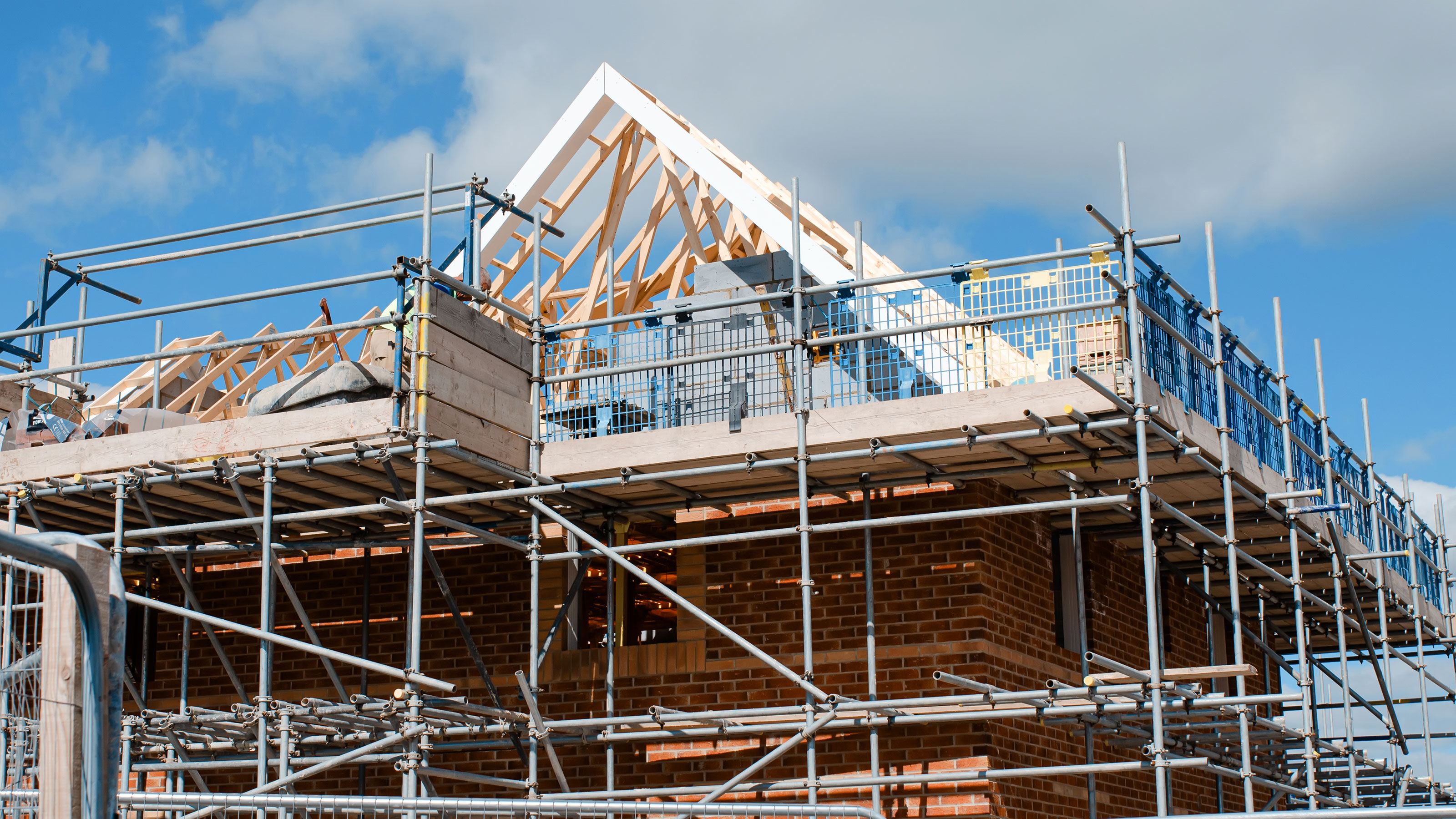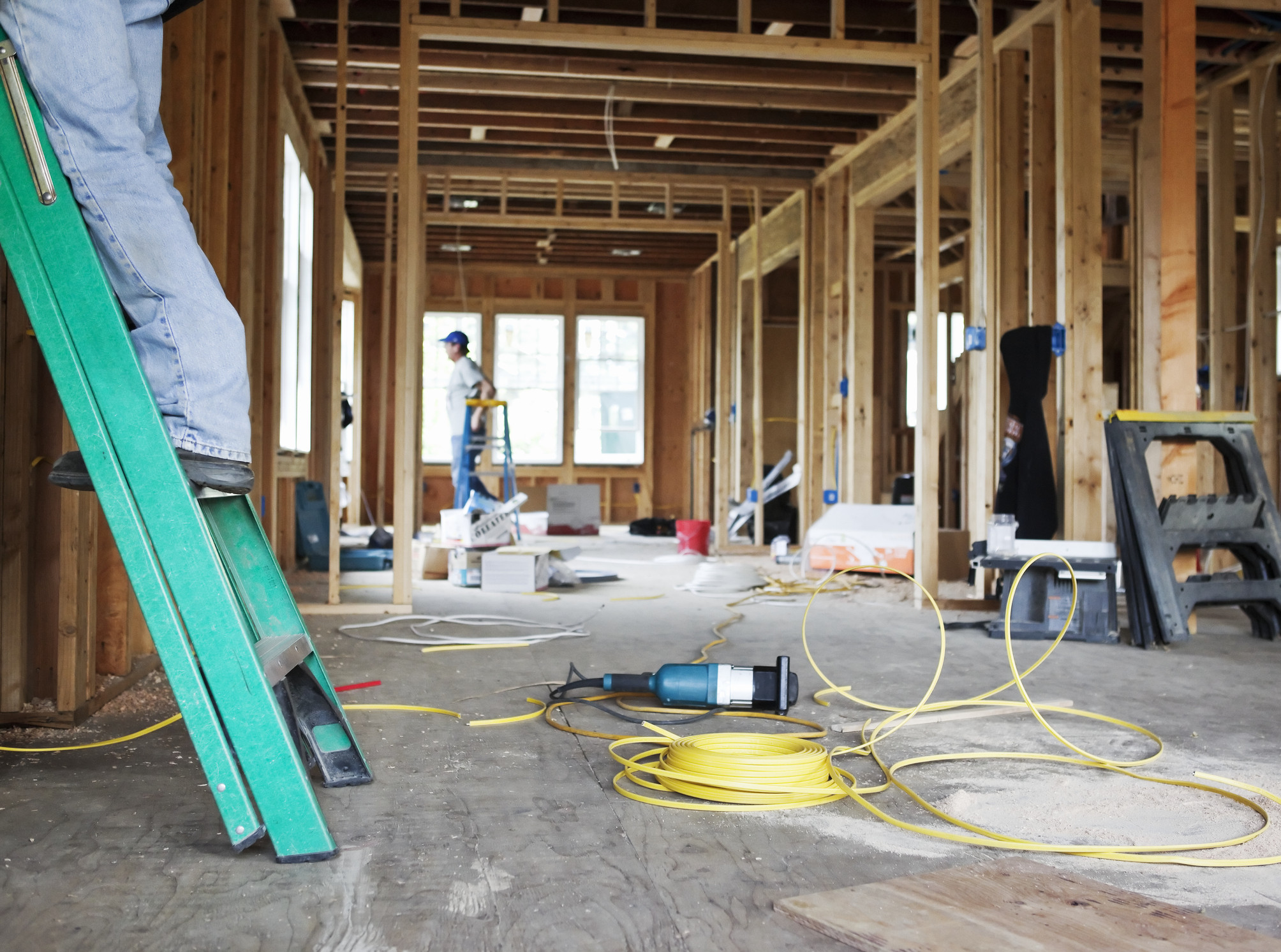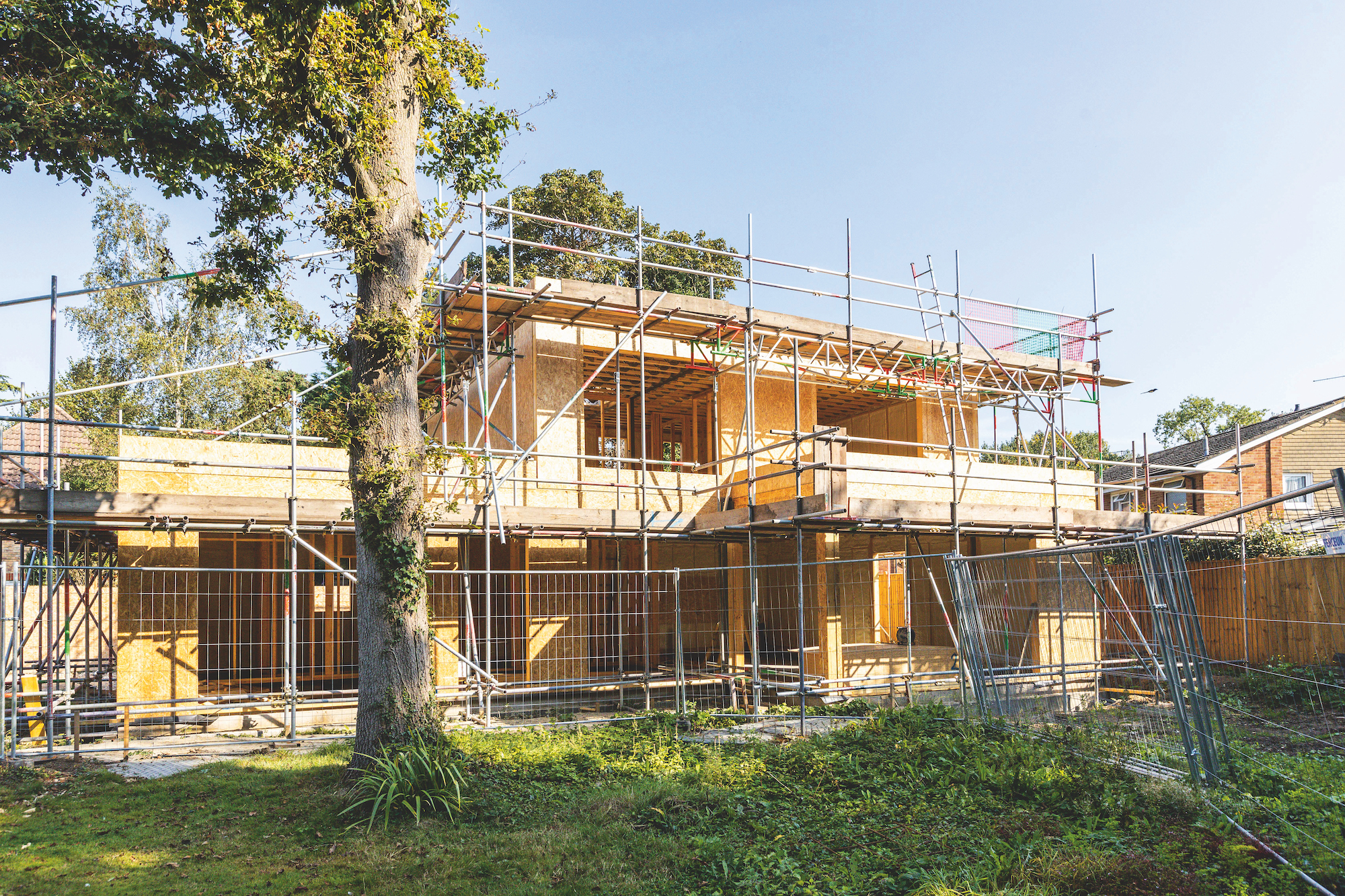Self build mortgages: Everything you need to know
Self build mortgages release funds at set stages during a project. Find out how a self build mortgage works, how to apply for one and what to expect in terms of the latest rates.

Self build mortgages are quite different to to traditional mortgages, releasing funds in stages in order to provide the cashflow needed for building a new home, paying for materials and paying your contractors.
This makes a self build possible even for those who can't afford to finance the entire build from savings. That said, there are some limitations that come with this type of mortgage. They're less widely available, which means they may be less competitive, and depending on the type of self build mortgage you choose, the rates are typically higher than a 'standard' mortgage.
Understanding the world of self build mortgages isn't easy, so we've created this guide explaining how they work and the types available. We've also found some of the newest self build mortgage products to hit the market, plus you'll find the latest rates, updated in August 2023.
What is a self build mortgage?

Need more advice or inspiration for your project? Get two free tickets to the Homebuilding & Renovating Show.
"Unlike a traditional residential mortgage where a single advance is generally made on completion of purchase, self build mortgage payments are released in stages," explains Daniel Capstick, mortgage manager at Ecology Building Society. "These staged releases reflect the progress and increasing value of the lender's security (your new home) from plot purchase to obtaining detailed planning consent and, of course, the build phases through to completion."
Before you start applying for a self build mortgage, there are a few key considerations to factor in:
- For a self build mortgage application you will need to provide plans and a breakdown of your build costs, including your plot cost. Use our Build Cost Calculator to find out what your project is likely to cost
- It’s wise to add on a contingency fund for any problems you may encounter further into the build too
- The interest rates are typically higher than the standard house mortgage or remortgage rates and the arrangement fees also vary from lender to lender
- Once your self build is habitable, some lenders will allow you to switch to a lower rate of interest
Watch our video to find out how self build mortgages work
When are funds released with a self build mortgage?
"Self build mortgages transfer money in stages as you build a house," explains Emma Lunn, a journalist who specialises in personal finance and property.
For a self build mortgage:
With a self build mortgage, funds are typically released at these key stages of a self build schedule:
- Land (with the minimum of outline planning permission)
- Substructure
- Wallplate/eaves height (just before the roof trusses go on)
- Wind and watertight roof tiled
- First fix
- Second fix
- Certified completion
For custom build or group self build projects:
- Purchase of land
- Associated preliminary costs and substructure
- Construction to wind and watertight stage
- First fix
- Second fix
- Completion
For renovation or conversion projects:
- Purchase of existing structure
- Inspected completion of structural survey and cost estimate of necessary works
- Completion of load bearing elements
- First fix
- Second fix
- Certified completion
"It's a good idea to get a decision in principle for a mortgage before looking for a building plot to buy; that way you can move quickly when you find the right plot," says Emma Lunn.

Are there different types of self build mortgage?
There are two types of self build mortgages that you can choose from:
- Arrears mortgages: If you have a large amount of cash to hand to finance some of your self build home, an arrears type self build mortgage is your best bet. These offer payments in stages after each stage of the build is complete, meaning you front up the money for the stage and are ultimately repaid.
- Advance mortgages: For those reliant on the mortgage to fund each stage, an advance mortgage releases payments at the start of each stage. This will mean you don't require short term or bridging loans to cover the build costs upfront if you were take out an arrears self build mortgage. For many people, this type of mortgage is understandably advantageous offering help with cash flow, however, there are fewer providers who offer this kind of mortgage, and the rates may not be as competitive as an arrears type mortgage.
Some lending institutions lend on the land purchase or existing property and at key stages during and on completion of the build project.
This can vary from:
- 75-80% of the purchase price or valuation (whichever of the two is the lower)
- Up to 80% of build costs
- Up to 75% of the growth in value of your project at key stages during construction
Some lending institutions do not lend on land, but they will lend during the build period.
Products available include:
- Discount from standard variable rate of interest
- Fixed rate of interest
- Bank base rate tracker
- Offset

How much can I borrow with a self build mortgage?
The amount you can borrow will depend on your unique financial circumstances — your income and outgoings (and any outstanding debts) will be used to establish how much you can borrow.
Chris Martin, head of product development at BuildStore, says: “Like other mortgages, the amount you can borrow will depend on your income and spending patterns, along with any other loans or credit you hold. As a general guide, most mortgage providers will consider lending around four-and-a-half times your gross yearly income.
"The amount you can borrow will also be limited by the mortgage product you choose," continues Martin. "Many products will potentially provide up to 80% of the value of your completed home, although products providing up to 95% of your build costs and 90% of the completed value are available through specialist advisers like BuildStore.”
Some self-build mortgages work on an interest-only basis while the build is going on. This can be great for budgeting, but you won’t reduce the balance of your mortgage during this time.
As with all mortgages, you will need to pass affordability and credit checks, and the loan will be ‘stress tested’.
"Unlike a mortgage for a house purchase, self build borrowing isn't limited by your plot or property's current value," comments Emma Lunn. "You can typically borrow up to 75% of your project costs, or more if you already own the plot of land.
"Every self build mortgage lender will have its own maximum loan amount. Some lenders also have separate limits on how much you can borrow for buying the land, the build costs ad the gross development value (the estimated value the house could sell for)."
Banks and building societies apply an affordability calculation to assess your borrowing limits. This will take the costs of any debts such as loans, credit cards, childcare costs.
A mortgage will not be granted if it is deemed not to be affordable.
Mortgages of this type are regulated by the Financial Conduct Authority.
Will I be eligible for a self build mortgage?
"As with any normal residential mortgage, some lenders have a really strict criteria and if you fall outside of this, your application will not be accepted," warns Joanne Leek from Suffolk Building Society.
Where you intend to live while you build will have an impact on your affordability to borrow monies to build your dream home. For instance, the monthly rental payments or mortgage payments (if you intend to stay in your existing home) will have an impact on your affordability calculation.
Some lenders will accept you making upfront rental payments, which will not have an impact on your monthly income versus expenditure.
"Other lenders, usually those who take a manual approach to underwriting (eg a person assesses the application), are in a better position to evaluate each application on its merits, which can be really helpful on a complicated self build project."
It's also worth noting that some lending institutions will not lend on certain construction systems, so do ensure you check with them.
Of course, all your design and construction methods will also need to be compliant with the current Building Regulations.
Each lender’s criteria are different, but you do need to ensure they are aware of your build type and of any payment terms and conditions your supplier has stipulated.
Some lenders require that you must work to a fixed build cost budget; others may request that a qualified quantity surveyor provides the information on the build costs.
Check with your lender what they require. Also, ensure that you include a minimum of a 20% contingency into your build cost estimate.
In addition, as part of your full project costs and budget control estimate that you provide your lender with, you’ll need to identify (or at the very least estimate) the following costs:
- Land purchase and associated fees
- Self build project management, including health and safety compliance
- Gaining planning permission, if not already achieved, and associated fees
- Demolition and/or site preparation
- Construction design fees
- Construction costs (preferably estimated against Building Regulations drawings)
You must demonstrate to the lender that you will have sufficient funding ability and competence in place to complete the project.

How do I apply for a self build mortgage?
The documentation required to apply for a self build mortgage is essentially the same as with a standard mortgage. However, additional supporting documentation will be required, which may include:
- Copy of planning permission
- Copy of construction drawings and specifications
- Copy of total project cost estimate (where possible, fixed-price contracts)
- Copy of Building Regulations approval
- Copy of site self build insurance and structural warranty
- Architect’s professional indemnity cover (if required)
- SAP calculation (this will be in the Building Regulations package)
- Experian credit report
An initial valuation will be carried out to establish current value and anticipated end value, too. (You will be required to pay the valuation fees.) Interim and final valuations will also be requested and carried out by a RICS valuer.
The reports will be presented to the lender to evidence the increase of the interim value(s) prior to interim and final release of funds from the lender.
Other key points to consider, include:
- A typical timescale for processing a stage release mortgage is up to three months
- Consultants, brokers, banks and building societies will carry out a forensic analysis of all supporting documents
- In particular, they will focus on income and expenditure cross checked with the bank statements

Can 'Help to Build' make it easier to get a self build mortgage?
While the government's relatively new Help to Build scheme can help self builders to finance a project, the scheme itself does not offer self build mortgages.
Through Help to Build, you can apply for an equity loan from the government of between 5% and 20% of the estimated build cost (up to 40% in London). However, you'll still need a self build mortgage in place to make use of this scheme, and you'll also need a mortgage from a provider registered with Help to Build.
You only get your equity loan and start to pay fees for it after you’ve built your home, after which the government will pay your mortgage lender the equity loan amount offered to you, and your self build mortgage will automatically switch to a repayment mortgage.
Which banks offer self build mortgages?
"There are currently about 26 mortgage providers in the UK which will lend on self build projects, but self-builders need to do their research before they apply," says Emma Lunn.
"A small number of self build lenders have withdrawn from the market in recent years. However, there are still plenty of self-build mortgage products available."
Take a look at the table below for a list with the latest rates.
What are the latest mortgage rates?
Self build mortgages are largely provided by specialist providers, so there's a fewer products available than standard mortgages.
Here are some of the providers who have recently launched self build mortgages or updated their deals:
Build Loan and Bath Building Society
Bath Building Society's Self Build range is available exclusively through BuildStore. The newest interest rates are between 5.6% and 8%, with a maximum loan to value (LTV) of 95%, or 100% if you already own your plot, with a maximum of up to 85% of the expected end value of your new home.
BuildLoan and Buckinghamshire Building Society
There are various self build mortgages available. Their '6.53 Self Build Advance - 2 Year Discount [SB4A]' mortgage has a 6.53% variable initial pay rate for the first two years, and a completion fee of £1,499. This is followed by their standard variable rate (SVR) of 8.59% for the rest of the term. Maximum loan to value is 80%, including fees.
Harpenden Building Society
This provider has improved their rates in recent months, offering a pay rate of 5.89% for mortgages between £150,000 and £999,999 and 6.69% for mortgages between £1m and £1.5m. This is followed by their standard variable rate of 7.79%. The updated deal also allows for flexible construction types, from independent builds to those that are not linked to stage-based building.
See some examples of the best self build mortgage deals as of August 2023 below:
| Lender | Contact | Max LTV | APRC | Initial Payment |
|---|---|---|---|---|
| Beverley BS | 01482 881510 | 80% | 7.8% | £1,124.12 |
| Hanley Economic BS | 01782 255 000 | 60% | 7.5% | £1,136 |
| Penrith BS | 01768 863675 | 75% | 7.8% | £1,145.77 |
| Melton BS | 01664 414141 | 75% | 8.2% | £1,145.77 |
| Saffron BS | 0800 072 1100 | 75% | 7.8% | £1,145.77 |
| Suffolk BS | 0330 123 0773 | 50% | 8.4% | £1,698 |
| Ecology BS | 01535 650770 | 80% | 6.5% | £1,178.62 |
These self build mortgage rates were complied by Moneyfacts in August 2023.
Are self build mortgage interest rates higher than standard mortgages?
Interest rates on a self build mortgage are higher than standard house purchase/remortgage rates and typically vary from 4-6% per annum. The arrangement fees also vary depending on the broker or lender. You may be tied into the lender for between one and three years, again lender and product dependent.
"While the lowest rate, minimal fees and the total loan amount may be uppermost in your mind for a house purchase, when it comes to building your own home, the single most important factor should be your cashflow and ensuring sufficient funds are available at the right time," advises Rachel Payne, operations director at BuildStore Mortgage Services.
"Look for a cost-based mortgage with guaranteed payments based on your project costs, irrespective of lender valuations, at each stage on your build."
Once the property is habitable and this has been confirmed by a RICS’ qualified surveyor and issue of the building control completion certificate, some lenders permit the borrower to ‘switch’ to a lower rate of interest during the ‘tie-in period’ without incurring penalty interest.
Do I change my mortgage once the build is complete?
"In order to keep costs down, some lenders allow mortgages to be repaid on an interest-only basis during the build period," says Emma Lunn.
"But once the property is complete, habitable and valued, and this has been confirmed by a RICS-qualified surveyor, you’ll be prompted to remortgage to a mainstream mortgage deal. This will be better for you as interest rates will be cheaper.
"Most lenders will offer a product switch at the end of your build onto a mortgage product with a lower rate. You should, however, watch out for any early repayment charges and talk to a broker to find you the best deal."
Can I use a bridging loan instead of a self build mortgage?
If you own your existing home or have enough equity in it, you may be able to remortgage or take out a bridging loan to pay for your new plot, fund the build costs, or even both. You would then sell your old house once you had completed the new one and pay off the loan.
"Bridging loans are short-term loans which can usually be arranged very quickly," explains Emma Lunn. "But this type of borrowing is expensive, and you’ll need an ‘exit strategy’ to be approved — this will normally be selling the property or refinancing to a standard mortgage.
"Bridging loans are secured against your property, putting it at risk if something goes wrong. You might also be working towards a deadline for completion so any delays in the build could mean incurring further costs."
Rachel Pyne of Buildstore adds: “It’s important to note that a regulated bridging loan secured on your main residence has a maximum term of 12 months. This means you must complete your new home and sell your old one in this time to repay the loan.”

Do I need insurance and warranties to get a self build mortgage?
A bank or building society may not release initial funds until you can demonstrate that you have a 10-year structural warranty policy in place. When taking out your warranty, it’s also a good time to ensure that you have the right site self build and renovation insurance policy in place to give you peace of mind should anything go wrong.
Anyone undertaking a build project, whether borrowing or not, should have both in place prior to starting work on site.
Subject to affordability, banks and building societies are keen to lend on residential construction projects, providing you have carried out due diligence and engaged the appropriate team(s) to achieve the successful construction of your new home.
Bring your dream home to life with expert advice, how to guides and design inspiration. Sign up for our newsletter and get two free tickets to a Homebuilding & Renovating Show near you.
Michael is Homebuilding & Renovating's Director of Content, Vice Chair of the self build industry body, the National Custom and Self Build Association (NaCSBA), presenter of multiple property TV shows and author of Renovating for Profit (Ebury). He also runs an architectural and interior design practice, offering design and project management services. He is one of the country's leading property experts and has undertaken over 30 building projects including two self-builds and the renovation of a Grade-II listed farmhouse.
Michael has presented over 150 property shows for BBC, ITV1, Channel 5, UK TV Style, and Discovery RealTime, including I Own Britain's Best Home; Don't Move Improve; Trading Up; Good Bid, Good Buy; Build, Buy or Restore?; How to Build A House; and Hard Sell.
Michael is also a regular expert at the Homebuilding & Renovating Shows. He has written for leading British newspapers, including The Daily Telegraph, Sunday Times, Daily Express and The Independent and has appeared on news programmes such as BBC Breakfast.

